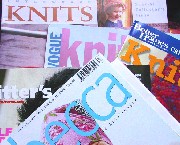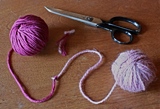 Careers in Fiber:
Careers in Fiber:Designing for Knitting Magazines
|
Getting published for the first time may seem daunting, especially if you don't know where to start. Here are some tips on how to get your foot in the knitwear design door and keep it there. Survey the Field For many, knitwear magazines are the best place to start. But simply sending out a form letter to all the magazines won't do. Each magazine has a slightly different focus, from family comfort to organic ingredients or sleek runway style. And magazines will change their focus from issue to issue. Your first task is to survey the market and determine the most appropriate publications for your designs. Don't be afraid to include the "big" magazines on your list, but also don't overlook the smaller ones. A publishing credit is a publishing credit. 3-2-1 Contact Once you've narrowed the field to a few prospects, it's time to make contact. The first thing to do is find out if the publication is accepting submissions. Although other magazines often include this type of information on their Web sites, most knitting magazines still don't. The best thing is to call, email, or write the publication directly. Woolworks.org maintains a list of knitting magazines worldwide here. Questions to ask:
Preparing Your Package: Focus, Focus If you're inclined to toss some sketches in an envelope, jot a quick note on a piece of paper, and drop the whole package in the mail, stop! Take some time -- even an hour if that's all you have -- to get clear on your underlying goals. What do you want to accomplish with this magazine? Is designing a pleasurable side hobby, or do you intend to make this your full-time business? Do you want to establish a long-term relationship with this particular magazine, or is it only a stepping stone for you to reach another goal? Once you've refreshed your focus, you're now safe to put together that package. Remember that the editors receive similar packages all the time. What can you do to make yours stand out? This isn't a matter of using fluorescent paper or stuffing the box with confetti -- although who knows, this could work. It's about making sure that every element of this package reflects you, your design aesthetic, and your ultimate goals. Turn Nothing into Something If you are new to designing, or just don't have any published patterns to your credit, you'll want to compensate for this by putting extra attention into your drawings, and providing extra-large swatches. It doesn't hurt to include a brief statement about yourself and what inspired you to create this design. If you have photos of previous un-published designs, you can always include those as well. You want to show the editors that you're a serious professional. Persistent or a Pest? After you've submitted your design for consideration, you'll have to practice a bit of patience. Some people get an answer within a week or two, but some magazines have been known to sit on patterns for several months before making a decision. It's fair to follow up with a quick email or call to verify that the materials were received. But beyond this, most editors don't look favorably on designers who call every other week for updates. Yes, you're keeping your name out there, but most likely not in the best of contexts. Regrettable Rejections? Never! If your pattern is turned down, don't despair. Thank the editors for their time, and make sure they return your materials. Each time you go through the submission process, you refine your goals, vision, and presentation. Even the best knitwear designers were turned down at first. Where would we be today if they had let those early rejections stop them? You're In? Now Give 'em What They Want If your design is accepted, congratulations! But before you can pop the champagne (or take out that skein of cashmere you've been saving for special occasions), you'll need to get through the negotiations. Here's what you can expect. Normally you'll be notified directly by the editor responsible for putting together that section of the magazine. This person will explain the payment structure and whether or not the payment is split between the magazine and a yarn manufacturer. Nitty Gritty of Negotiations The sad truth is that you won't make a fortune publishing designs for magazines. Smaller ones have been known to pay a token $50 to $75 per design, while the larger ones generally cap out at $500 unless you're an exceptionally famous designer. To offset these costs, magazines will often split them with a yarn manufacturer. In exchange, the manufacturer supplies you with the yarn necessary to produce a new sample garment, and then the final pattern in the magazine will call for that particular yarn. If your editor says that the fee is split, find out if you must invoice the two parties separately and, if so, to whom you should address the invoices. Some editors may also ask you to rework portions of your pattern, which you should be willing to do. Normally such reworkings are only minimal. And finally, don't forget the most important thing: Find out if your name will be included with the published pattern and who holds the copyright. The value of getting your name out there almost surpasses any payment you may receive, because it helps establish you as a knitwear designer. Magazines will often hold first publication rights and then release the copyright back to you once the magazine comes out. If they want to retain all rights permanently, take a few moments to decide if you want to proceed. Yes, you'll be published, but you'll also lose all future rights to that pattern. Depending on where you are in your career -- and how fond you are of that pattern -- your decision may vary. Delivering the Goods: Know When to Get Help Depending on when you happen to reach the magazine, you may be asked to deliver the finished pattern and sample within a matter of weeks. If you know you won't have time to produce a new knitted sample quickly, you may want to establish a relationship with a contract knitter. These experienced knitters-for-hire can produce your garments quickly and, in the process, help identify any problems with your patterns. Paying Contract Knitters There is no universal fee schedule for contract knitters. One common technique is to pay the knitter a set amount for each yard of yarn used, with averages ranging from $0.05 to $0.08 per yard. If your pattern calls for 1200 yards, then the total cost will average $80. This technique is good for standard sweaters, but it gets tricky if your pattern calls for complex, time-consuming stitchwork or multiple colors that are stranded throughout the work. That's why some designers prefer to offer a flat rate based on the amount of time it would take them to knit the item themselves. It's not uncommon to pay $5 per hour, with an experienced knitter capable of finishing a standard women's sweater in 30 to 35 hours (costing $150 to $185). Yes, this can be a hefty investment. If you maintain future rights to the pattern, you'll easily be able to recoup these production costs by selling copies of the pattern later. To locate contract knitters, you can start by contacting your local yarn shops and then making a few queries in knitting forums or email lists. If you meet a contract knitter via the Web, it's totally permissible to request samples of his or her work. But Don't Stop There Now you've sent in your finished pattern and sample. Whew! Time to leave town for that Caribbean vacation. No, not quite. If you have a pattern in production with a magazine, it's very important that you stay available to answer any last-minute questions or deal with issues that may pop up. There's nothing more frustrating for an editor than to have a designer disappear at the last minute. If you really must take that trip, then make sure you bring your cell phone and laptop with you. If you deliver the goods and maintain a positive, flexible, and available attitude throughout the entire process, you'll get repeat work. It's that simple. Final Niceties Once the pattern is in production, it's time to strike while the iron is hot. Send your invoice to the magazine and, if applicable, to the yarn manufacturer who supplied your materials. If everything went smoothly and you trust there won't be a problem with payment, it's also a gracious touch to include a quick thank-you card to both parties. Doing so helps establish name recognition with the yarn manufacturer, which could lead to next week's career move discussion: designing for yarn companies. Additional Resources for Designers |




